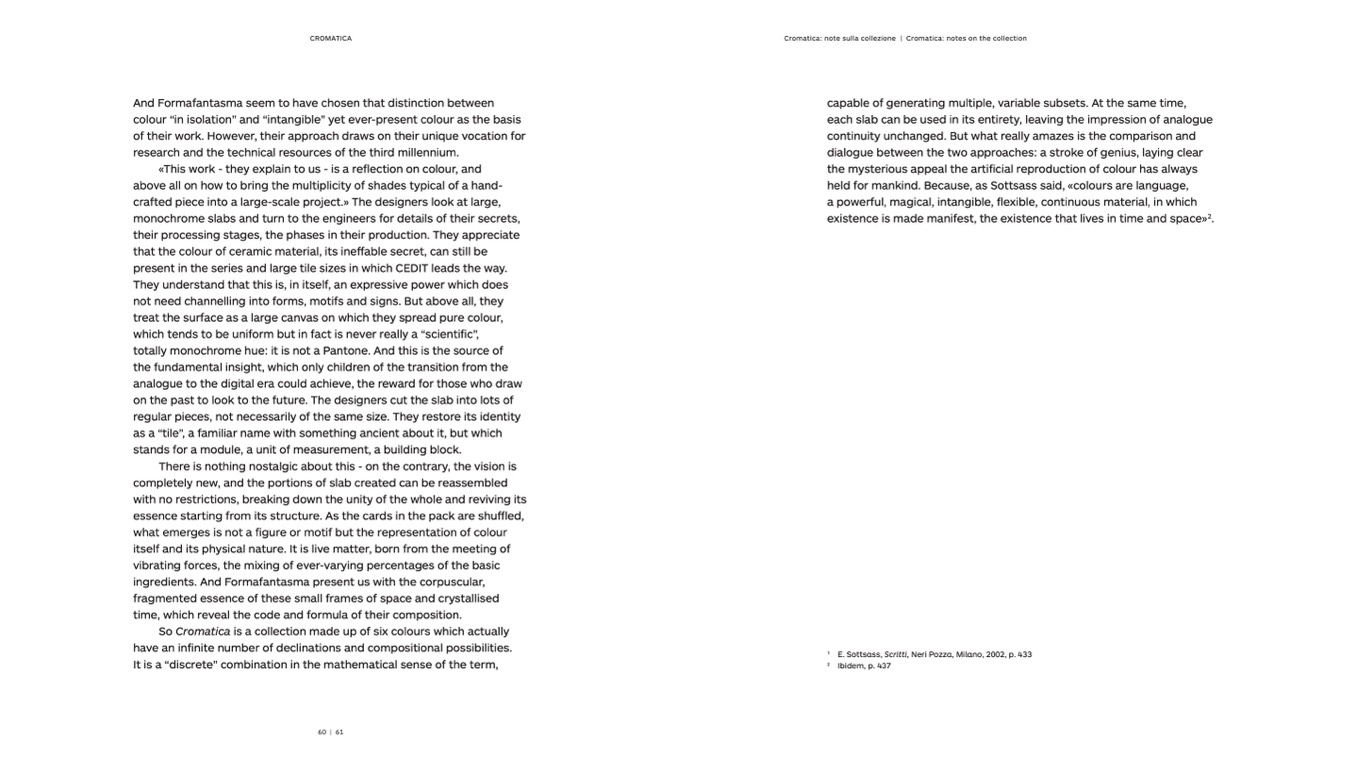
CROMATICA
Cromatica: note sulla collezione | Cromatica: notes on the collection
And Formafantasma seem to have chosen that distinction between
colour “in isolation” and “intangible” yet ever-present colour as the basis
of their work. However, their approach draws on their unique vocation for
research and the technical resources of the third millennium.
«This work - they explain to us - is a reflection on colour, and
above all on how to bring the multiplicity of shades typical of a hand-
crafted piece into a large-scale project.» The designers look at large,
monochrome slabs and turn to the engineers for details of their secrets,
their processing stages, the phases in their production. They appreciate
that the colour of ceramic material, its ineffable secret, can still be
present in the series and large tile sizes in which CEDIT leads the way.
They understand that this is, in itself, an expressive power which does
not need channelling into forms, motifs and signs. But above all, they
treat the surface as a large canvas on which they spread pure colour,
which tends to be uniform but in fact is never really a “scientific”,
totally monochrome hue: it is not a Pantone. And this is the source of
the fundamental insight, which only children of the transition from the
analogue to the digital era could achieve, the reward for those who draw
on the past to look to the future. The designers cut the slab into lots of
regular pieces, not necessarily of the same size. They restore its identity
as a “tile”, a familiar name with something ancient about it, but which
stands for a module, a unit of measurement, a building block.
There is nothing nostalgic about this - on the contrary, the vision is
completely new, and the portions of slab created can be reassembled
with no restrictions, breaking down the unity of the whole and reviving its
essence starting from its structure. As the cards in the pack are shuffled,
what emerges is not a figure or motif but the representation of colour
itself and its physical nature. It is live matter, born from the meeting of
vibrating forces, the mixing of ever-varying percentages of the basic
ingredients. And Formafantasma present us with the corpuscular,
fragmented essence of these small frames of space and crystallised
time, which reveal the code and formula of their composition.
So Cromatica is a collection made up of six colours which actually
have an infinite number of declinations and compositional possibilities.
It is a “discrete” combination in the mathematical sense of the term,
capable of generating multiple, variable subsets. At the same time,
each slab can be used in its entirety, leaving the impression of analogue
continuity unchanged. But what really amazes is the comparison and
dialogue between the two approaches: a stroke of genius, laying clear
the mysterious appeal the artificial reproduction of colour has always
held for mankind. Because, as Sottsass said, «colours are language,
a powerful, magical, intangible, flexible, continuous material, in which
existence is made manifest, the existence that lives in time and space»
2
.
60 | 61
1
E. Sottsass, Scritti, Neri Pozza, Milano, 2002, p. 433
2
Ibidem, p. 437

